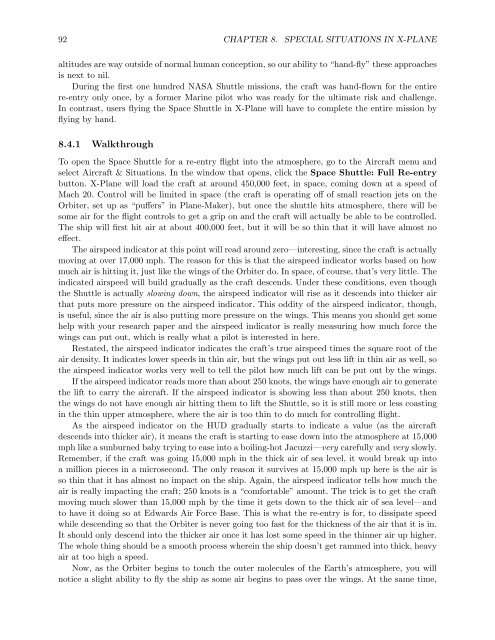Download the X-Plane 10 Manual - X-Plane.com
Download the X-Plane 10 Manual - X-Plane.com
Download the X-Plane 10 Manual - X-Plane.com
Create successful ePaper yourself
Turn your PDF publications into a flip-book with our unique Google optimized e-Paper software.
92 CHAPTER 8. SPECIAL SITUATIONS IN X-PLANE<br />
altitudes are way outside of normal human conception, so our ability to “hand-fly” <strong>the</strong>se approaches<br />
is next to nil.<br />
During <strong>the</strong> first one hundred NASA Shuttle missions, <strong>the</strong> craft was hand-flown for <strong>the</strong> entire<br />
re-entry only once, by a former Marine pilot who was ready for <strong>the</strong> ultimate risk and challenge.<br />
In contrast, users flying <strong>the</strong> Space Shuttle in X-<strong>Plane</strong> will have to <strong>com</strong>plete <strong>the</strong> entire mission by<br />
flying by hand.<br />
8.4.1 Walkthrough<br />
To open <strong>the</strong> Space Shuttle for a re-entry flight into <strong>the</strong> atmosphere, go to <strong>the</strong> Aircraft menu and<br />
select Aircraft & Situations. In <strong>the</strong> window that opens, click <strong>the</strong> Space Shuttle: Full Re-entry<br />
button. X-<strong>Plane</strong> will load <strong>the</strong> craft at around 450,000 feet, in space, <strong>com</strong>ing down at a speed of<br />
Mach 20. Control will be limited in space (<strong>the</strong> craft is operating off of small reaction jets on <strong>the</strong><br />
Orbiter, set up as “puffers” in <strong>Plane</strong>-Maker), but once <strong>the</strong> shuttle hits atmosphere, <strong>the</strong>re will be<br />
some air for <strong>the</strong> flight controls to get a grip on and <strong>the</strong> craft will actually be able to be controlled.<br />
The ship will first hit air at about 400,000 feet, but it will be so thin that it will have almost no<br />
effect.<br />
The airspeed indicator at this point will read around zero—interesting, since <strong>the</strong> craft is actually<br />
moving at over 17,000 mph. The reason for this is that <strong>the</strong> airspeed indicator works based on how<br />
much air is hitting it, just like <strong>the</strong> wings of <strong>the</strong> Orbiter do. In space, of course, that’s very little. The<br />
indicated airspeed will build gradually as <strong>the</strong> craft descends. Under <strong>the</strong>se conditions, even though<br />
<strong>the</strong> Shuttle is actually slowing down, <strong>the</strong> airspeed indicator will rise as it descends into thicker air<br />
that puts more pressure on <strong>the</strong> airspeed indicator. This oddity of <strong>the</strong> airspeed indicator, though,<br />
is useful, since <strong>the</strong> air is also putting more pressure on <strong>the</strong> wings. This means you should get some<br />
help with your research paper and <strong>the</strong> airspeed indicator is really measuring how much force <strong>the</strong><br />
wings can put out, which is really what a pilot is interested in here.<br />
Restated, <strong>the</strong> airspeed indicator indicates <strong>the</strong> craft’s true airspeed times <strong>the</strong> square root of <strong>the</strong><br />
air density. It indicates lower speeds in thin air, but <strong>the</strong> wings put out less lift in thin air as well, so<br />
<strong>the</strong> airspeed indicator works very well to tell <strong>the</strong> pilot how much lift can be put out by <strong>the</strong> wings.<br />
If <strong>the</strong> airspeed indicator reads more than about 250 knots, <strong>the</strong> wings have enough air to generate<br />
<strong>the</strong> lift to carry <strong>the</strong> aircraft. If <strong>the</strong> airspeed indicator is showing less than about 250 knots, <strong>the</strong>n<br />
<strong>the</strong> wings do not have enough air hitting <strong>the</strong>m to lift <strong>the</strong> Shuttle, so it is still more or less coasting<br />
in <strong>the</strong> thin upper atmosphere, where <strong>the</strong> air is too thin to do much for controlling flight.<br />
As <strong>the</strong> airspeed indicator on <strong>the</strong> HUD gradually starts to indicate a value (as <strong>the</strong> aircraft<br />
descends into thicker air), it means <strong>the</strong> craft is starting to ease down into <strong>the</strong> atmosphere at 15,000<br />
mph like a sunburned baby trying to ease into a boiling-hot Jacuzzi—very carefully and very slowly.<br />
Remember, if <strong>the</strong> craft was going 15,000 mph in <strong>the</strong> thick air of sea level, it would break up into<br />
a million pieces in a microsecond. The only reason it survives at 15,000 mph up here is <strong>the</strong> air is<br />
so thin that it has almost no impact on <strong>the</strong> ship. Again, <strong>the</strong> airspeed indicator tells how much <strong>the</strong><br />
air is really impacting <strong>the</strong> craft; 250 knots is a “<strong>com</strong>fortable” amount. The trick is to get <strong>the</strong> craft<br />
moving much slower than 15,000 mph by <strong>the</strong> time it gets down to <strong>the</strong> thick air of sea level—and<br />
to have it doing so at Edwards Air Force Base. This is what <strong>the</strong> re-entry is for, to dissipate speed<br />
while descending so that <strong>the</strong> Orbiter is never going too fast for <strong>the</strong> thickness of <strong>the</strong> air that it is in.<br />
It should only descend into <strong>the</strong> thicker air once it has lost some speed in <strong>the</strong> thinner air up higher.<br />
The whole thing should be a smooth process wherein <strong>the</strong> ship doesn’t get rammed into thick, heavy<br />
air at too high a speed.<br />
Now, as <strong>the</strong> Orbiter begins to touch <strong>the</strong> outer molecules of <strong>the</strong> Earth’s atmosphere, you will<br />
notice a slight ability to fly <strong>the</strong> ship as some air begins to pass over <strong>the</strong> wings. At <strong>the</strong> same time,














